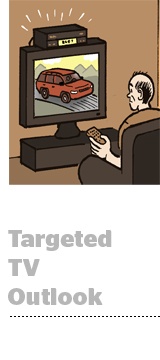 CES has always been about TV, and 2017 was no exception.
CES has always been about TV, and 2017 was no exception.
Displays got a whole lot sharper and devices got a whole lot thinner. But the TV advancements most relevant to marketers and advertisers revolve not around the hardware but the software, which enables addressable ads and better measurement.
To be fair, CES isn’t exactly ground zero for that type of conversation, but executives hoping to advance ad delivery and content measurement in TV were certainly well-represented.
MVPD Versus TV?
Traditionally, MVPDs like satellite and cable companies have been the movers and shakers in addressable TV, said Jamie Power, managing partner at WPP’s advanced TV buying unit, MODI Media. After all, they own the subscriber files. But that might change in the third quarter of 2017, which is when she expects Samsung to move into the ad market with a beta platform that matches against television device IDs, rather than subscriber files.
“So you won’t need the match with the MVPDs anymore,” Power said. “I’ve seen a demo of the product, and it functions more like digital: The ads are inserted dynamically, in real time. They can do real frequency capping and measure what’s on the glass and serve ads accordingly.”
To power this capability, Samsung is working with Sorenson Media and Gracenote, a recent Nielsen acquisition. Sorenson, which has partnerships with broadcasters Hearst and Sinclair, will provide access to local broadcast inventory. That’s new for MODI, which traditionally inserts ads into cable.
And Gracenote, which has a similar deal with TV manufacturer LG, powers the data-driven back end.
“We supply the infrastructure for Samsung to measure data on its TVs, and we license data to Samsung, which powers their consumer applications – like universal search in their latest TVs,”
said Gracenote Chief Product Officer Richard Cusick. “We provide consumer data, and we provide the stitching that ties consumer data to action items.”
Gracenote showcased the effect of this technology in Samsung TV sets at CES. It wasn’t dynamically stitching an ad unit into a pod – instead, messages related to the TV content would pop up in a dedicated space on the screen.
For others, however, the idea of addressability goes beyond the television set.
“When we think of addressability, we don’t think of it in terms of what the cable companies have enabled through a set-top box,” said Ashwin Navin, CEO and co-founder of Samba TV. “We see a high percentage of consumption on second- or third-screen devices of prime-time TV shows.”
His hope is to get around traditional TV infrastructure – which holds back automation and addressability – by applying digital buying methods and measurements to video holistically, including linear TV, video on demand, OTT and mobile video.
Excel With Automation
Jay Stocki, SVP of data and product at Experian Marketing Services, attended CES primarily to promote how his company can facilitate the data transfers needed to make addressable TV work.
Video and cable provider infrastructure is falling into place, he noted, pointing to Cablevision’s early entrance into the New York tristate region and Charter, Cox and Comcast expanding their infrastructures.
“Now that you have this addressable component of TV advertising, you’ve got this fantastic ability to measure, and you have to think about frequency-capping television impressions,” Stocki said. “That’s tougher on the linear buy side. But if you have video IP-based channels, you need to get those together so you can frequency-cap and understand that measurement.”
At CES, Stocki wanted to figure out the plans for other over-the-top (OTT) technology providers such as TiVo, which launched an audience measurement platform, and Netflix, which might have to resort to advertising revenue if the incoming Trump administration kills off net neutrality.
But while addressable TV is growing – Stocki said Experian has run 200 campaigns for 100 different brands – it’s still plagued by challenges that go beyond basic infrastructure. With 50 to 60 million addressable US households, Stocki thinks there’s certainly enough potential scale to justify addressable buying, even if there isn’t yet an abundance of inventory. And both Experian and its competitor Acxiom are working to streamline the flow of data needed to power addressable buys.
But big process issues also need to be resolved. Experian’s addressable TV offering is very services-oriented, Stocki said.
“Media providers really like working with us, but it’s very demanding on our data staff to generate reports and work with brands or agencies to understand what the report means,” he explained. “It has to become more software-oriented, or we’ll explode.”
And if you think the data wonks have it rough, wait ’til you hear about what the buyers go through.
MODI’s Power recalls 3-a.m. nights surrounded by Excel spreadsheets.
“I don’t think people realize what a manual process it is,” she said. “It must be manual because you have to make sure the campaign is set up the right way.”
She anticipates this process will get better incrementally – and that 2017 will bring some level of automation to addressable TV buying that will help the practice scale. The process of delivering media to each MVPD, for instance, involves collating and delivering stacks of Excel documents and PDFs that detail what exactly needs to be measured in the campaign.
Power is hoping upon hope that, this year, the industry will be able to automate just the media delivery portion of the addressable buy.
“It’s a different mindset for clients when they do an addressable TV campaign,” she said. “The first one they do, they always ask for a schedule. But there is no schedule for addressable television because you don’t know where the spots are going to run.”
This post was syndicated from Ad Exchanger.

More Stories
TBWA\ New Zealand event provides insights into the future of sport
Fashion Brands Are Now Partnering With Media Titans to Spur Significant Sales Boost
Together reports for media and data duties at Inghams